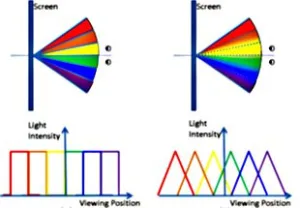One of the challenges in many autostereoscopic display technologies is that of producing a smooth variation in the 3D imagery as the viewer moves in user space. That is, of producing smooth motion parallax along the horizontal axis. Recent developments on addressing this issue have been reported by a team of researchers headed by Munekazu Date of the NTT Media Intelligence Labs. Details of the team’s latest autostereoscopic display are presented in an article entitled “Smooth Motion Parallax Autostereoscopic 3D Display Using Linear Blending of Viewing Zones.” The article was published in the SID 2015 Digest on pages 983 – 986.
An additional and significant advantage claimed for the team’s approach over conventional multi-view or high density directional display technologies is a favorable tradeoff between the number of viewing zones (quantity of information) and 3D image quality (smoothness of the horizontal motion parallax). The figure below illustrated discrete image zones on the left and blended image zones on the right.
The starting point for the team’s development derives from the physiological/psychological principles that underlie operation of the autostereoscopic Depth-Fused Display. In a DFD, identical images are presented on two 2D flat panel displays placed in optical series. The total luminance of the displays is the same as that of the image to be displayed. The luminance ratio of the two displays depends on the desired depth of the object. When the displays are separated by a (small) gap that is appropriate to the viewing distance, the images fuse into one image with the perceived depth determined by the luminance ratio.
In their recently reported work, the team proposed to use this effect for interpolating two adjacent images in a horizontal array of video projectors. The details of this technology are discussed in the article.
In summary, the team reports that it was possible to produce smooth motion parallax from a limited number of image sources. They report accomplishing “optical linear blending based on vertical convolution of diamond shaped projector irises.” They go on to explain that “The proposed optical system makes it possible to provide any horizontal angular luminance profile of a viewing zone with high precision merely by changing the shapes of the projector irises.”
Since the approach achieved smooth motion parallax, it is possible to reduce the number of image zones (and, hence, the number of image sources) and, instead, interpolate viewing points between viewing zones.
Other features of the approach include the following:
- Proper depth is produced independent of the users’ interpupilary distance.
- Multiple users can simultaneously view the display each viewer receiving an image appropriate to their particular viewpoint.
- The latency for user’s movement is inherently zero.
–Arthur Berman

